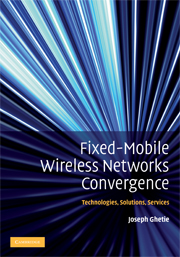Book contents
- Frontmatter
- Contents
- Disclaimer
- How the Book is Organized
- List of Figures
- List of Tables
- Preface
- Acknowledgments
- Acronyms
- Part I Wireless Communications: Networking and Management
- Part II Cellular Mobile Radio Networking and Management
- Part III Fixed Wireless Technologies: Networking and Management
- Part IV Fixed Wireless Cellular Mobile Networks Convergence and Integration
- 10 Fixed-Mobile Convergence Overview
- 11 Wireless LAN Cellular Mobile Convergence
- 12 Wireless PAN Cellular Mobile Convergence
- 13 Wireless MAN Cellular Mobile Convergence
- 14 Wireless Sensor Networks Cellular Mobile Convergence
- Part V Fixed Wireless Cellular Mobile Networks Convergence: Standardized Networking Solutions
- Part VI Fixed-Mobile Convergence Services, Industry Trends, and Implementation Issues
- References
- Index
14 - Wireless Sensor Networks Cellular Mobile Convergence
from Part IV - Fixed Wireless Cellular Mobile Networks Convergence and Integration
Published online by Cambridge University Press: 21 August 2009
- Frontmatter
- Contents
- Disclaimer
- How the Book is Organized
- List of Figures
- List of Tables
- Preface
- Acknowledgments
- Acronyms
- Part I Wireless Communications: Networking and Management
- Part II Cellular Mobile Radio Networking and Management
- Part III Fixed Wireless Technologies: Networking and Management
- Part IV Fixed Wireless Cellular Mobile Networks Convergence and Integration
- 10 Fixed-Mobile Convergence Overview
- 11 Wireless LAN Cellular Mobile Convergence
- 12 Wireless PAN Cellular Mobile Convergence
- 13 Wireless MAN Cellular Mobile Convergence
- 14 Wireless Sensor Networks Cellular Mobile Convergence
- Part V Fixed Wireless Cellular Mobile Networks Convergence: Standardized Networking Solutions
- Part VI Fixed-Mobile Convergence Services, Industry Trends, and Implementation Issues
- References
- Index
Summary
RFID Technology Development
Radio Frequency Identification (RFID) is a technical evolution of the bar code system. The goals are similar, i.e., to identify goods, items, and objects in general, using labels and dedicated label readers. Both bar code systems and RFID employ wireless technologies [73]. Despite these similarities, there are some differences. This is shown in Table 14.1.
The differences are in the areas of convenience (line-of-sight), environmental requirements, and, above all, in their capacity to identify individual objects. Bar coding is capable of identifying classes of similar objects but not individual items. And, here is the major advantage of RFID; it is an excellent candidate to provide tracking systems for individual items throughout the supply chain.
In this context, the supply chain is a staged suite of processes. It starts with the procurement of raw materials or basic components, followed by manufacturing or assembling goods, quality control, distribution, and, finally, the retail processes. The needs and the advantages of labeling have been known since the time of assembly lines, and systems resembling wireless identification were applied decades ago. But only in the current stage of mobile communications do we have a technology capable of identifying and tracking items in real-time.
At the heart of RFID technology labeling systems is the Electronic Product Code (EPC). It resembles the Universal Product Code (UPC) used in bar code systems.
- Type
- Chapter
- Information
- Fixed-Mobile Wireless Networks ConvergenceTechnologies, Solutions, Services, pp. 270 - 286Publisher: Cambridge University PressPrint publication year: 2008

